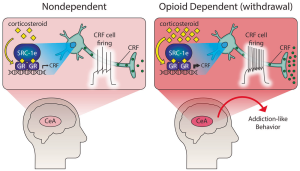 Hot Off the Press – April 5, 2022
Hot Off the Press – April 5, 2022
Published in Molecular Psychiatry by Stephanie Carmack and Leandro Vendruscolo et, al. of the NIDA IRP Neurobiology of Addiction Section.
Summary
The sharp increase in opioid overdose-related deaths in the United States is a public health emergency. An urgent search to uncover the biological mechanisms of opioid use disorder (OUD) is underway with the goal of identifying potential therapeutic targets. In a new study published in Molecular Psychiatry, researchers from nine institutions, led by the Integrative Neuroscience Research Branch in the NIDA Intramural Research Program, investigated the role of brain stress systems in driving opioid addiction-like behavior.
Opioid withdrawal is a severely emotionally painful state (hyperkatifeia) that activates specific stress-engaged brain circuits. Intense stress leads to high levels of corticosteroids, such as glucocorticoids, circulating in the body. The researchers found evidence for glucocorticoid receptor-dependent changes in stress systems in opioid dependence across three species: humans, rats, and zebrafish. Blocking glucocorticoid receptors reduced opioid addiction-like behaviors in male and female rats and zebrafish. It also decreased a marker of brain stress system activation, excitability of corticotropin-releasing factor neurons, in the rat amygdala. The researchers additionally found evidence for adaptations in glucocorticoid receptor signaling in the amygdala of humans with OUD. The team concludes that this brain system may represent a target to treat the “stress side” of OUD. The graphic (Figure 6 in the published paper) illustrates how this glucocorticoid receptor signaling pathway may change in the central amygdala in opioid dependence.
Publication Information
Corticosteroid sensitization drives opioid addiction Journal Article
In: Mol Psychiatry, 2022, ISSN: 1476-5578.
